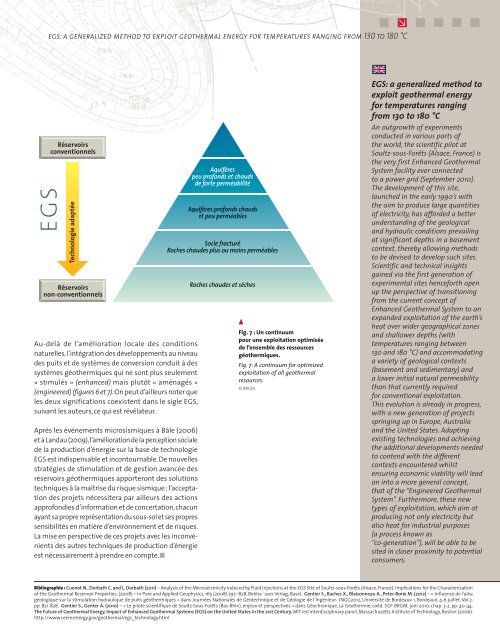revue_geosciences16
revue_geosciences16
revue_geosciences16
You also want an ePaper? Increase the reach of your titles
YUMPU automatically turns print PDFs into web optimized ePapers that Google loves.
egs: a generalized method to exploit geothermal energy for temperatures ranging from 130 to 180 °C<br />
conventionnels<br />
Technologie adaptée<br />
EGS Réservoirs<br />
Réservoirs<br />
non-conventionnels<br />
Au-delà de l’amélioration locale des conditions<br />
naturelles, l’intégration des développements au niveau<br />
des puits et de systèmes de conversion conduit à des<br />
systèmes géothermiques qui ne sont plus seulement<br />
« stimulés » (enhanced) mais plutôt « aménagés »<br />
(engineered) (figures 6 et 7). On peut d’ailleurs noter que<br />
les deux significations coexistent dans le sigle EGS,<br />
suivant les auteurs, ce qui est révélateur.<br />
Après les événements microsismiques à Bâle (2006)<br />
et à Landau (2009), l’amélioration de la perception sociale<br />
de la production d’énergie sur la base de technologie<br />
EGS est indispensable et incontournable. De nouvelles<br />
stratégies de stimulation et de gestion avancée des<br />
réservoirs géothermiques apporteront des solutions<br />
techniques à la maîtrise du risque sismique ; l’acceptation<br />
des projets nécessitera par ailleurs des actions<br />
approfondies d’information et de concertation, chacun<br />
ayant sa propre représentation du sous-sol et ses propres<br />
sensibilités en matière d’environnement et de risques.<br />
La mise en perspective de ces projets avec les inconvénients<br />
des autres techniques de production d’énergie<br />
est nécessairement à prendre en compte.ó<br />
Aquifères<br />
peu profonds et chauds<br />
de forte perméabilité<br />
Aquifères profonds chauds<br />
et peu perméables<br />
Socle fracturé<br />
Roches chaudes plus ou moins perméables<br />
Roches chaudes et sèches<br />
Fig. 7 : Un continuum<br />
pour une exploitation optimisée<br />
de l’ensemble des ressources<br />
géothermiques.<br />
Fig. 7: A continuum for optimized<br />
exploitation of all geothermal<br />
resources.<br />
© BRGM.<br />
EGS: a generalized method to<br />
exploit geothermal energy<br />
for temperatures ranging<br />
from 130 to 180 °C<br />
An outgrowth of experiments<br />
conducted in various parts of<br />
the world, the scientific pilot at<br />
Soultz-sous-Forêts (Alsace, France) is<br />
the very first Enhanced Geothermal<br />
System facility ever connected<br />
to a power grid (September 2010).<br />
The development of this site,<br />
launched in the early 1990’s with<br />
the aim to produce large quantities<br />
of electricity, has afforded a better<br />
understanding of the geological<br />
and hydraulic conditions prevailing<br />
at significant depths in a basement<br />
context, thereby allowing methods<br />
to be devised to develop such sites.<br />
Scientific and technical insights<br />
gained via the first generation of<br />
experimental sites henceforth open<br />
up the perspective of transitioning<br />
from the current concept of<br />
Enhanced Geothermal System to an<br />
expanded exploitation of the earth’s<br />
heat over wider geographical zones<br />
and shallower depths (with<br />
temperatures ranging between<br />
130 and 180 °C) and accommodating<br />
a variety of geological contexts<br />
(basement and sedimentary) and<br />
a lower initial natural permeability<br />
than that currently required<br />
for conventional exploitation.<br />
This evolution is already in progress,<br />
with a new generation of projects<br />
springing up in Europe, Australia<br />
and the United States. Adapting<br />
existing technologies and achieving<br />
the additional developments needed<br />
to contend with the different<br />
contexts encountered whilst<br />
ensuring economic viability will lead<br />
on into a more general concept,<br />
that of the “Engineered Geothermal<br />
System”. Furthermore, these new<br />
types of exploitation, which aim at<br />
producing not only electricity but<br />
also heat for industrial purposes<br />
(a process known as<br />
“co-generation”), will be able to be<br />
sited in closer proximity to potential<br />
consumers.<br />
Bibliographie : Cuenot N., Dorbath C. and L. Dorbath (2011) – Analysis of the Microseismicity Induced by Fluid Injections at the EGS Site of Soultz-sous-Forêts (Alsace, France): Implications for the Characterization<br />
of the Geothermal Reservoir Properties. (2008) – In Pure and Applied Geophysics, 165 (2008) 797–828, Birkha¨user Verlag, Basel. Gentier S., Rachez X., Blaisonneau A., Peter-Borie M. (2012) – « Influence de l’aléa<br />
géologique sur la stimulation hydraulique de puits géothermiques » dans Journées Nationales de Géotechnique et de Géologie de l’Ingénieur- JNGG2012, Université de Bordeaux 1, Bordeaux, 4-6 juillet, Vol.2.<br />
pp. 821-828. Gentier S., Genter A. (2010) – « Le pilote scientifique de Soultz-Sous-Forêts (Bas-Rhin), enjeux et perspectives » dans Géochronique, La Géothermie, coéd. SGF-BRGM, juin 2010, chap. 3-2, pp. 40-44.<br />
The Future of Geothermal Energy, Impact of Enhanced Geothermal Systems (EGS) on the United States in the 21st Century, MIT led interdisciplinary panel, Massachusetts Institute of Technology, Boston (2006).<br />
http://www1.eere.energy.gov/geothermal/egs_technology.html












